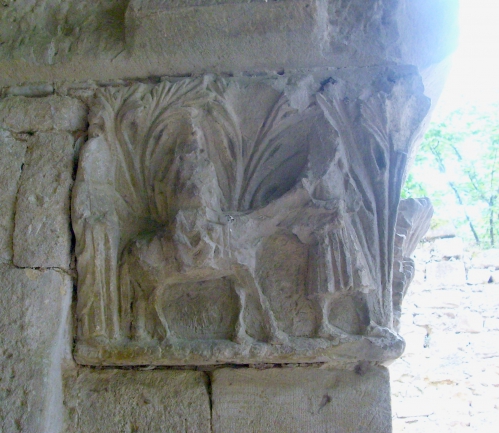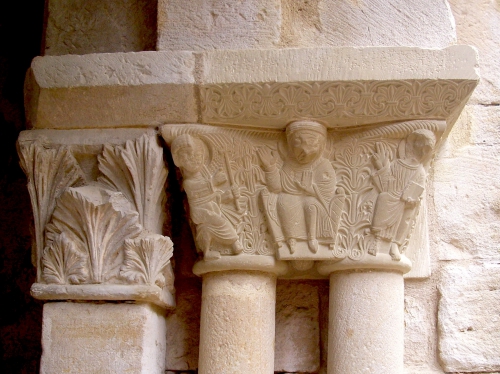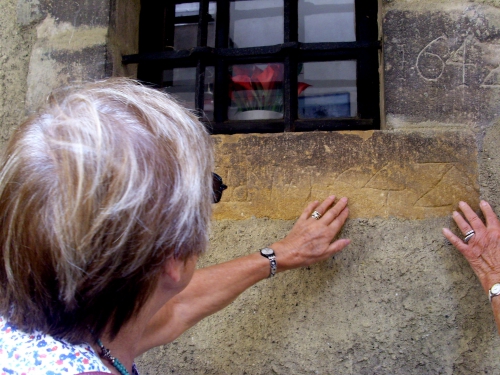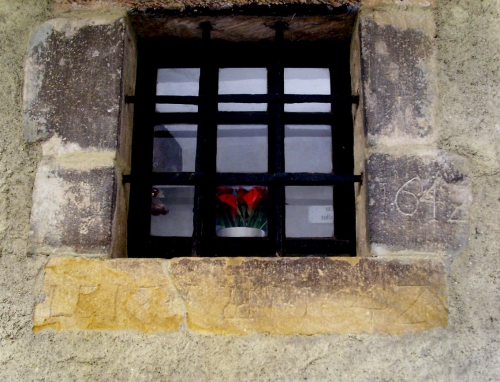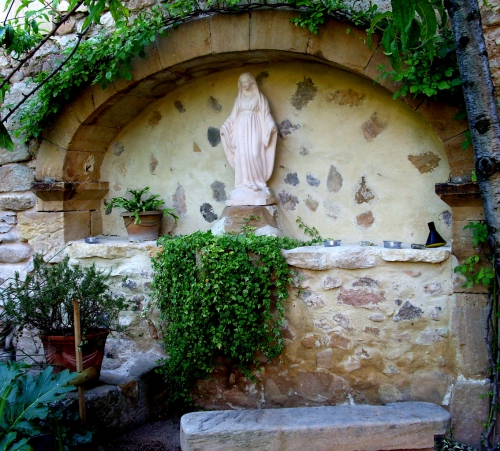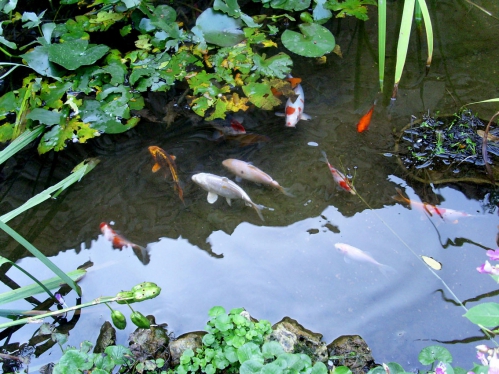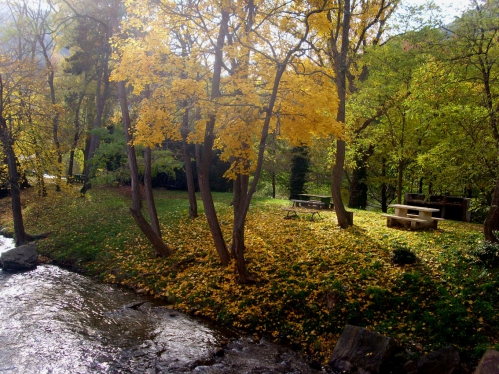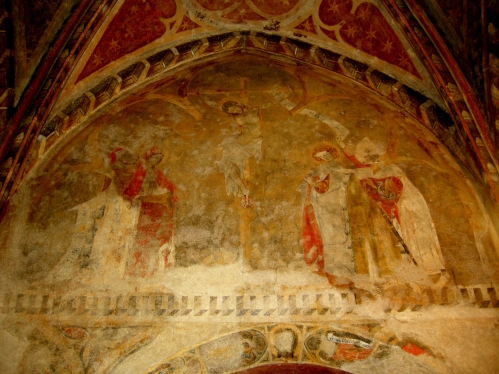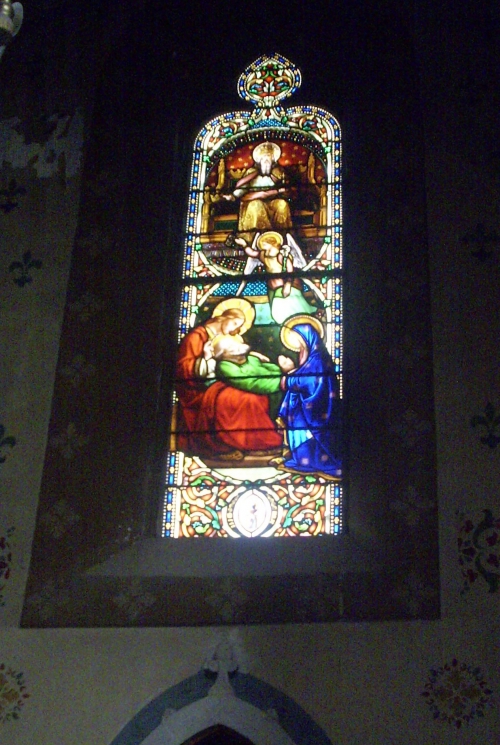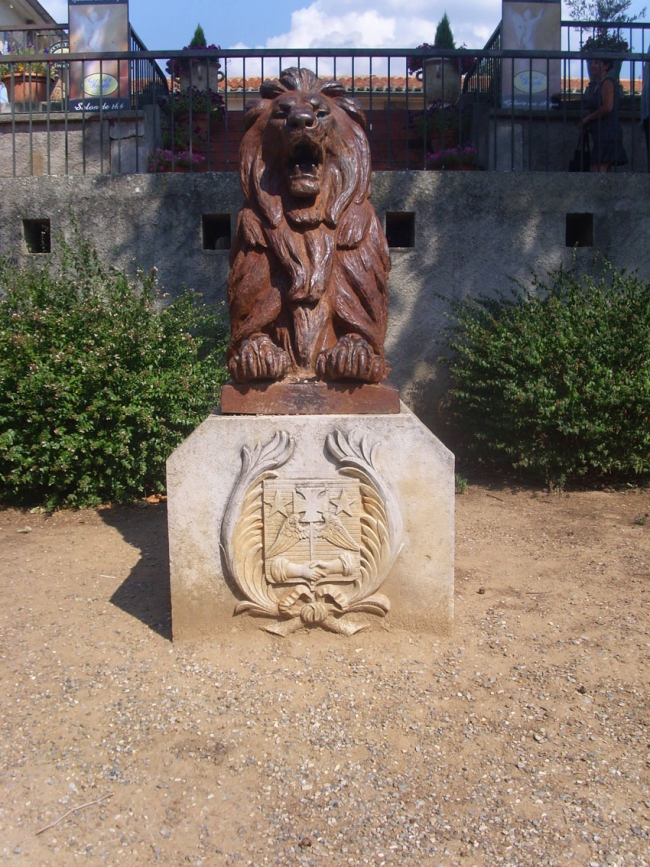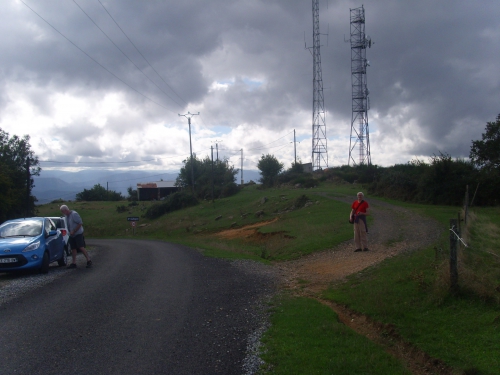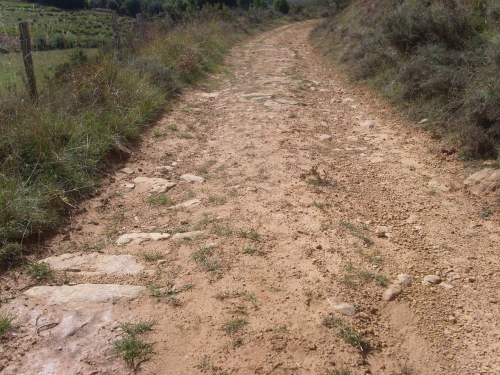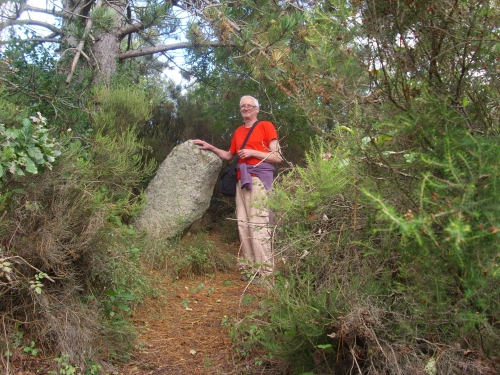Alet-les-Bains - Secrets
Hidden corners?
The regional historian Father Lasserre described Alet; "placed like a basket of flowers in a delightful valley that God took pleasure in enriching with all the gifts of nature." The secrets of Alet are there in front of people's eyes but they never see them!
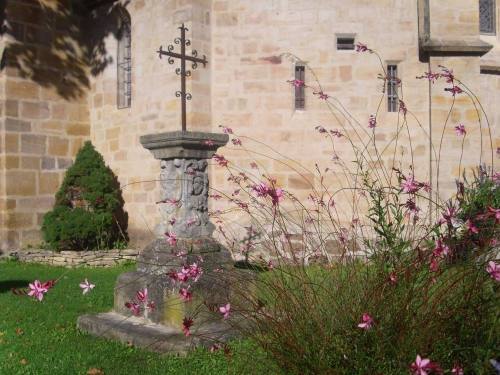
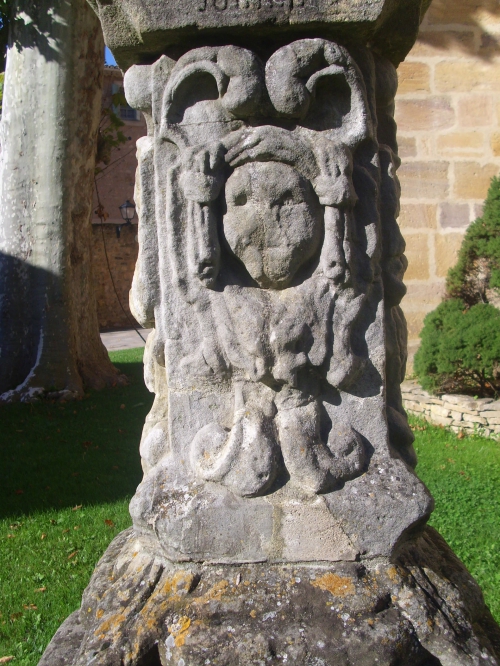
In front of the church there is this strange cross. All are agreed it is definitely "pagan." But where it came from and how it came there, no-one seems to know. But I have some ideas! Above it is a "modern" slab with the word "Mission" on it. It was re-used in exactly the same way that the Visigothic pillar was used at Rennes-le-Château by Bérenger Saunière, also to comemorate a Mission. St. André church at Alet les Bains was in the process of renovation when Béremger Saunière was the vicar there, before he went to Le Clat. Just saying.
The Cathedral
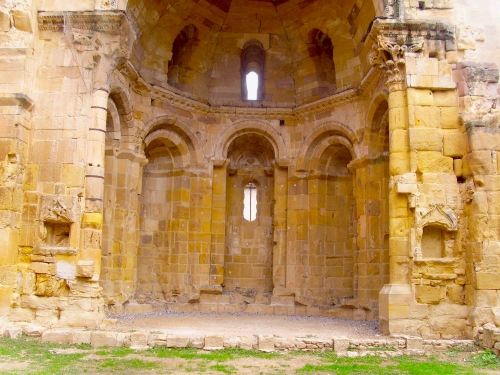
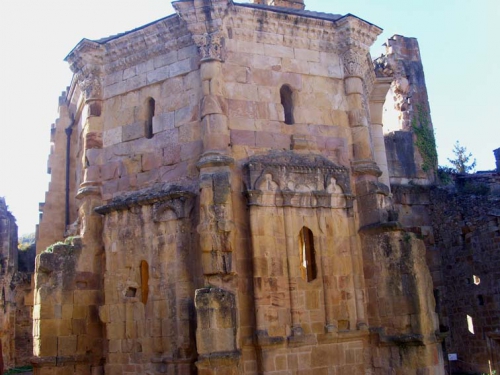
The space where the altar was, and the wall behind it.
You can see that the shape of this structure is hexagonal which, I have been told, is a sure sign it was a Temple to Isis! And on the day I was visiting, a ginger cat strolled across the space and my friend said; "A cat is a sign of Isis!"
This is the cathedral as seen from the road; to the right of it is the little Tourist Office, where you buy your ticket for a few Euros and can then go out of the door into the grounds and explore for yourself. It is far from completely ruined and includes the "church", the abbey, and the chapter house. In fact, you can see new stonework on the right (behind the white flowers) as work is continuing slowly but surely.
Strange Beasts
From the graveyard next door you can see many carvings on the walls of the abbey.
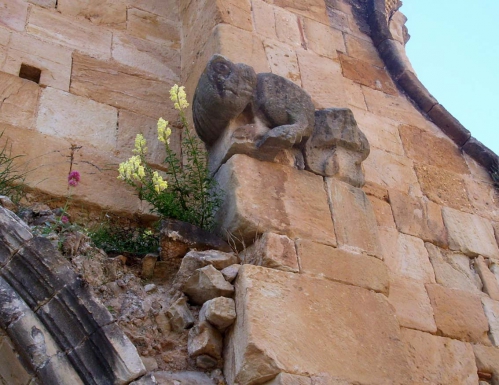
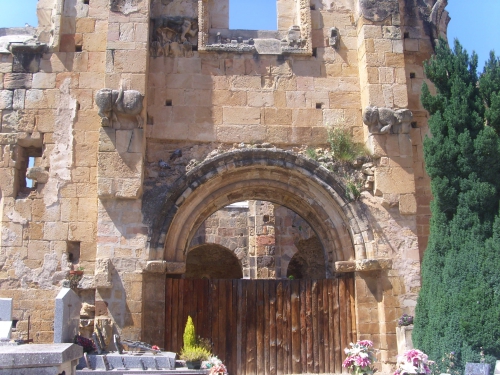
It is said the Abbey was Byzantine in style, as the window proves, and these strange creatures also seem to prove it. But who sculpted them? And did Count Bera journey to Constantinople, which was the seat of the Eastern Roman Empire then?
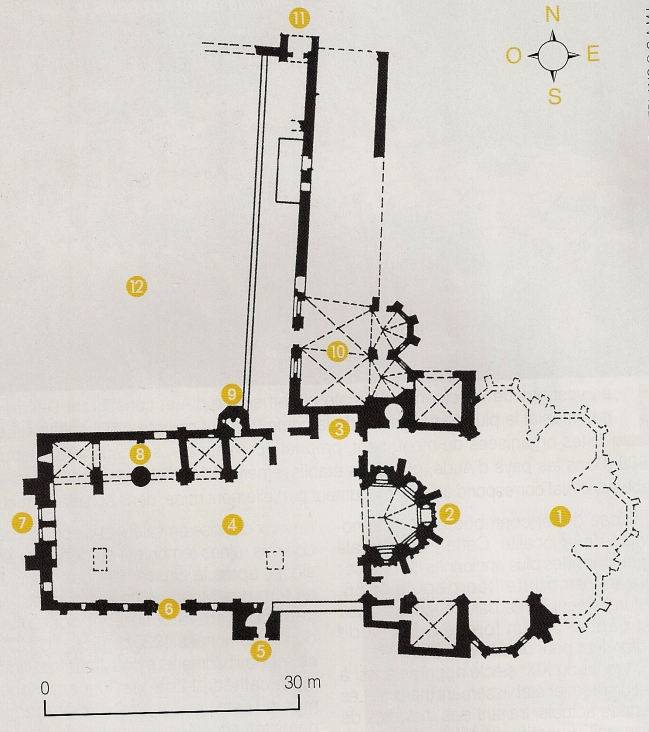
Look at the plan. The picture above is no 2, the Apse; the wall behind the altar that you can see from the road. The part marked 1 used to be the choir, and one could walk around the back of the altar within the church. The dotted line marks the back wall of the cathedral that was bombarded by the cannon balls of the Protestants during the wars of religion in the 16th century, and destroyed. I was particularly fascinated by the ground plan, for it is exactly the same as the Cathedral in Narbonne (which is bigger but same plan), built in 1272, and the church of St. Paul Serge in Narbonne, built around 100 years earlier. But the Cathedral in Alet was built in 803AD by Bera, the Visigothic Count of Rennes-le-Château, in what is called a Byzantine style. Was he ahead of his time?
However, we need to remember that this abbey was built on the site of an existing monastery, hence the graveyard between it and the church is very old. The church itself was built later than both of them.
I am sure the alcoves around the altar were filled with beautiful statues of the saints. If you turn you back on the space you are facing down the nave of the church ( number 4) and at the end, facing west, are windows (7) with a view of the Bishop's garden.
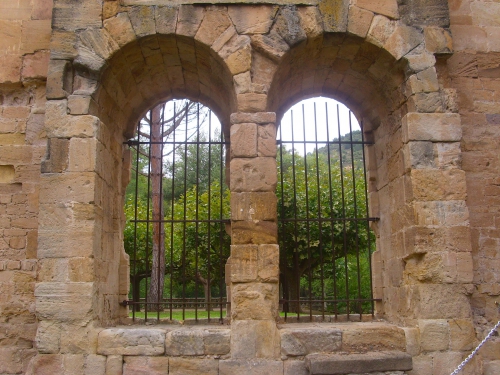
No 5 is the clock tower of St. Michael (the Cathedral was dedicated to Sainte Mary - Our Lady - as was common at the time) and you can still see, and climb up if you are brave, the circular staircase in it. On the nave is a a side chapel. On the right near no 3, is the entrance to the pathway the Bishop took to his palace (which is now a smart hotel.)
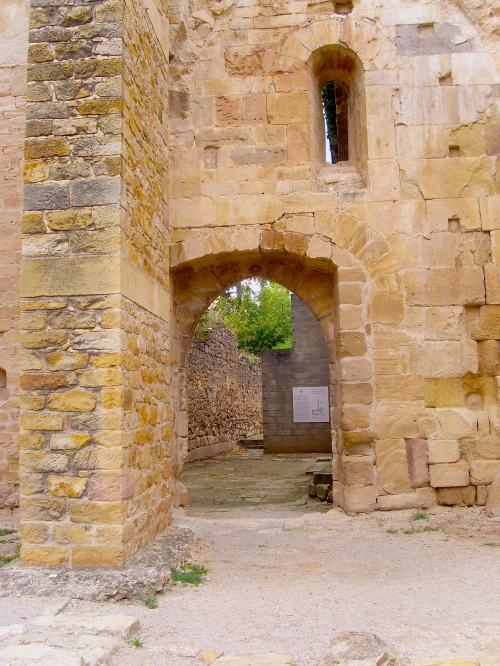
We went through there to find the Chapter House, no 10, on the right. It was full of carvings, some renovated, some not.
The first represents the Flight into Egypt.
The windows were Romanesque in style. With just a hint of Visigothic horsehoe arches.
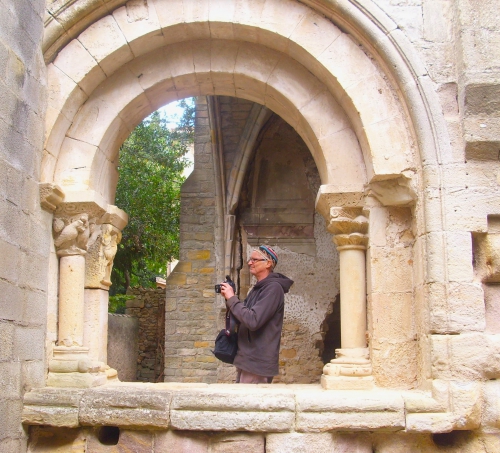
This chapter house (a place where monks met, meetings with superiors was held, and probably where they ate as well) is magnificent, and will be tremendous when restored.
The cathedral is also visible from the graveyard between it and the church. You can freely visit the graveyard and observe the south facing wall of the cathedral, on which is a magnificent crucifix showing a muscular Jesus. It is modern in concept, around 1900.
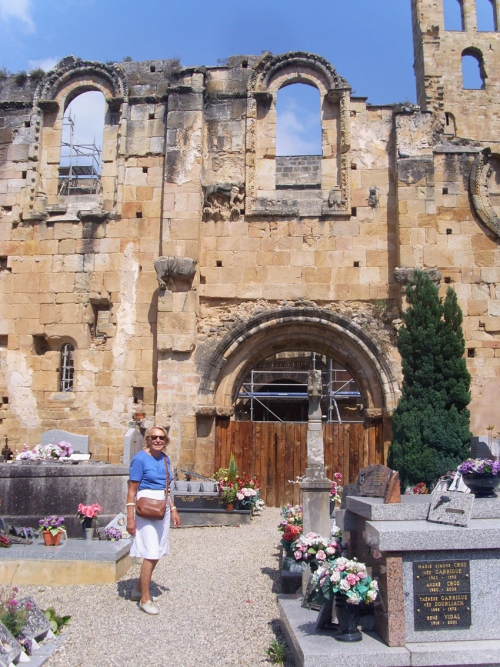
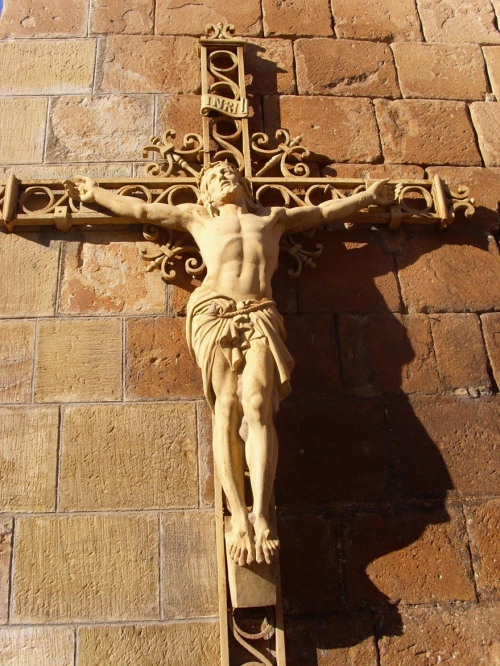
Alet-les-Bains is a small town but at one time it as a leading religious centre, a diocese ruling the area from just south of Carcassonne to St. Paul de Fenouillet in the Pyrenees. The last abbot of the abbey became the first bishop, and the Bishop's Palace was built beside the river. There was great controversy there in the 17th century, time of Louis XIV, for Nicholas Pavillon the bishop refused to spend hismoney on luxurious apartments for visiting church dignitaries but gave it to the poor instead. Pavillon's grave is in the churchyard.
Nostradamus's House
By the main square with its statue of Athene, at the corner with the rue Malbec, is the house where Nostradamus used to live, the home of his grandparents. 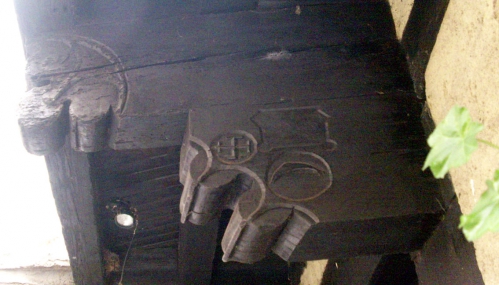
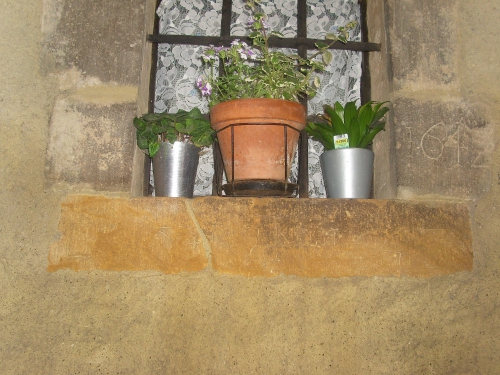
On the beams are carvings with Jewish associations, and underneath the window is a stone with a message carved into it, including 1642. But the date is not a date. The figures 1642 or 1643 have been found on Templar buildings all over France, in the Vendee, Gers, Poitiers region, and Roussillon. Some think the figures represent the "road of stars" - the pilgrim's route to Compostella in Spain. But the Templars were disbanded in 1307. . . Did Compostella pilgrims pass by Nostradamus's house in the seventeenth century? Was the house built on the site of a former Templar place of the 13th century?
Nostradamus had converted to Catholicism, and his main home was in Salon in Provence, where he wrote his famous predictions. Ten of them referred to treasure to be found in the Razès area, and other verses said the "Great Monarch" would come again and could be found at Rennes-les-Bains. The mystic Pierre Plantard, who more-or-less began the Rennes-le-Château mysteries, thought that he himself was the Grand Monarch. Among others!
One day I had been visiting Alet and on the bus back home I got talking to a French lady called Patricia, delightful company, and she told me she lived in Nostradamus's house in Alet! It used to be let as a gîte, but no longer. The owner gave up on letting it to holiday-makers and so Patricia has been living in it for two years - three now. And she invited me to visit her there! This was quite a "scoop" - well, how many people do you know that have been inside Nostradamus's house? - and so I arranged to go the following Friday with friends Gabi, Kris Darquis and Jean-Luc.
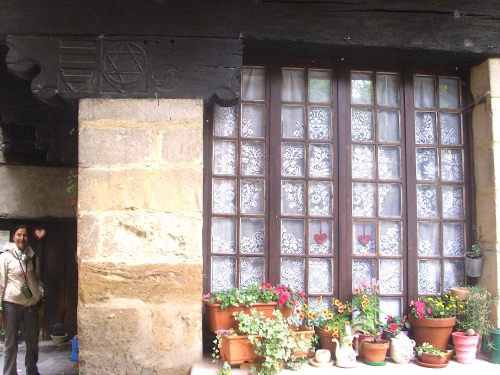
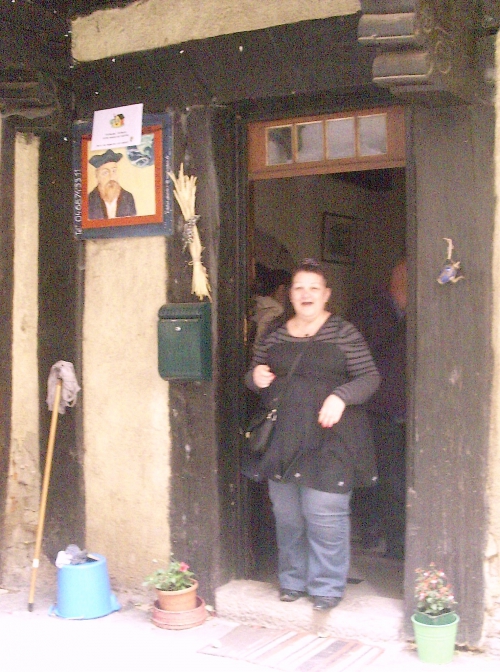
Patricia was not in the least concerned when I turned up with 3 friends half an hour late! We found her in "la place" cheerfully chatting to neighbours, including Nicholas de Léon the well-known tour guide, and she showed us the inside of the house and offered us a drink. Patricia is good company and told us that she came to Alet from Strasbourg for a holiday fifteen years ago and hasn't gone back yet. I can relate to that.
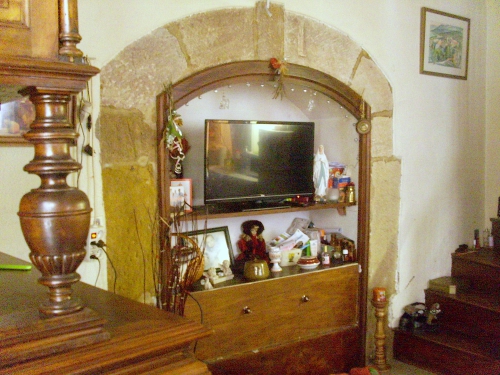
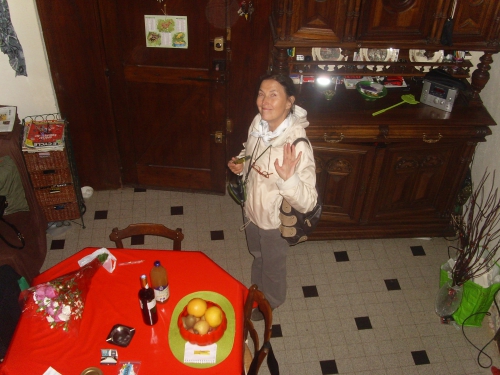
The fireplace and the dresser were original, the rest of the house has naturally been renovated over the years. There is a wonderful view over Alet from the top floor. The visit gave me certainly an idea of Nostradamus's visits there as a student.
Myself and my friends are not psychic but Nostradamus was, as his predictions prove. Ten of his verses mention the Razès, the old name for the region ruled from Rennes-le-Château. I wondered if a psychic person might be able to add to our knowledge here by visiting the house? Contact me on ValW@valwineyardpublishing.com
Nostradamus was technically Catholic, but had only converted for political reasons. He was Jewish and there was a Jewish area in Alet-les-Bains, as witnessed by the street called rue Juiverie.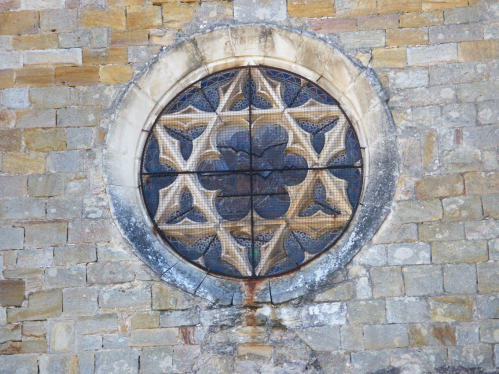
This leads us to a mini-mystery. The church, St. Andre, has windows in the shape of the Star of David. Many British researchers saw this as evidence that Nostradamus' family and the other Jews contributed to the renovation of this church. But the date, on the top of the window, reads 1888 - long after the Jews had left.
The answer came from our friend Etienne, who sent us this photo;

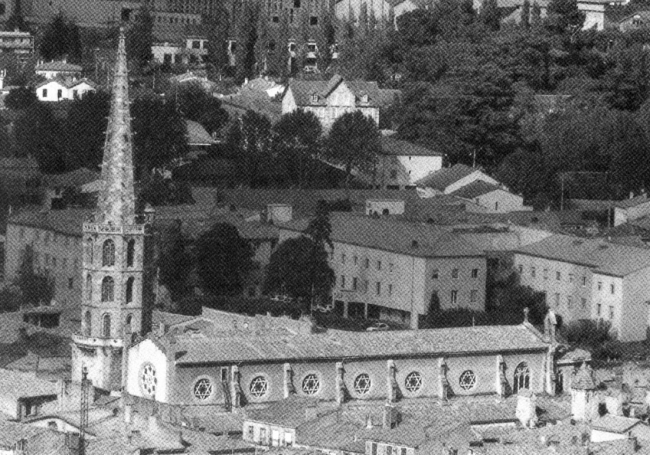
It shows a window in the church of St. Martin, at Limoux, 8km away, taken from inside the church. You can see the Star of David shape. This is a style of window often used in churches in our region in the late 19th century and has no mysterious significance whatsoever. Here is an old picture of St. Martin at Limoux from the outside.
The church is surrounded by a sea of houses - all you can see on the ground is the front door! The windows are all "stars of David." The theory that the Jews donated to building the Church of St Andrew, are quite simply not true.
Back to Nostra Damus - Notre Dame, our lady. The cathedral was dedicated to Nostra Damus - was this why Nostradamus chose it as a pen-name, after his diplomatic conversion to Catholicism?
Nostradamus lived from 1503-1566. His writings are thought to predict events in world history far into the future with a remarkable degree of accuracy, according to some. Is it really possible he lived in Alet? Yes. Firstly he spent his student years in Avignon and Montpellier; visits to grandparents in Alet would have been in order, especially when his school in Avignon was closed. He "went to the countryside researching herbal cures" - at Alet - and he later became a doctor. So no doubt he studied the thermal curative waters too.
In later life he suffered from gout and one likes to think he sought relief from the pain in the warm waters of Alet's natural springs.
Across the road from the church of St. Andre is the rue Seminaire - continue along it to the rue de Cadene, and then the Porte Cadene. This used to be the main Roman road. Outside the Porte Cadene the road continues and on the left is what used to be the Celtic oppidum. The strange stone construction, with round holes in it, was later used, it's said, for pigeons.
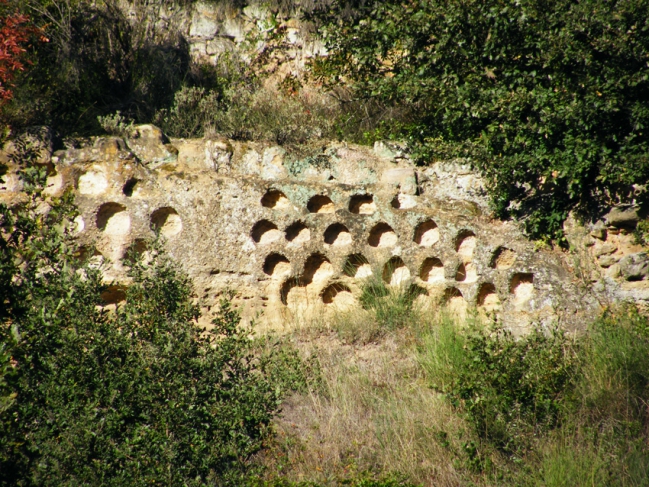
However, I did solve the mystery of those niches in the rocks, it is in my Alet book, and it might well amaze you!
Our Dear Priest
Alet was the home of Berenger Sauniere; he was the Vicar, or assistant priest there, five weeks after his ordination on 7th June 1879. In Berenger Sauniere's time Alet was ruled from Carcassonne; his bishop was Billard and one believes they were friends.
You might like to stop at La Buvette and find it to be housed in the old Seminary, or priests' training school. It has been made into a chambres d'hôtes. In the entrance hall I felt certain that the recently ordained Bérenger had once sat before this ancient fireplace on winter nights, chatting to fellow priests . . .
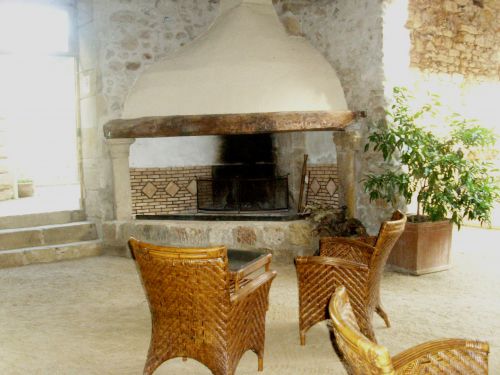
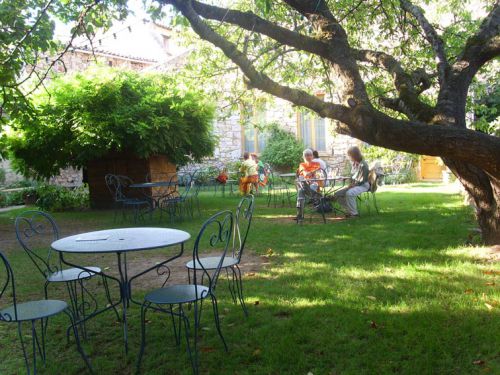
Outside was a Virgin, a pool, and a most peaceful and lovely garden.
The buvette is open only in the summer, but what is open all the year round is the little grocer's shop opposite the church on the road built in the 18th century. The lady makes a sandwich for you while you wait, and then you buy some wine and sit on the tables opposite. Or you can take your picnic to the picnic spot underneath the trees on the island in the river.
St Andrew's Church
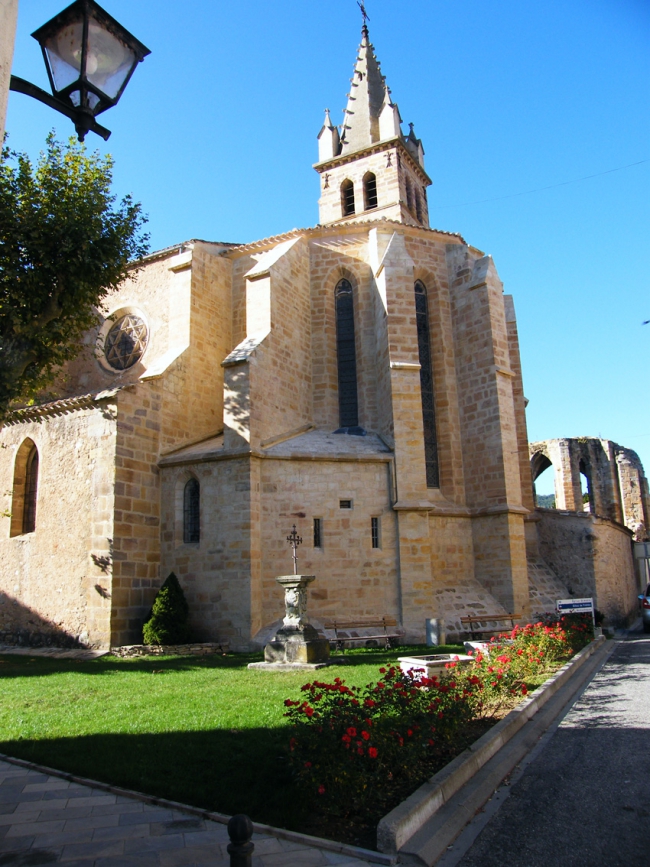
You can find it beside the main road near the cathedral, a part of which can be seen in the background of the picture. The graveyard is between the two. The church is not generally open, but if you go around the back you will see notices from an English group who worship there who could advise you.
There are many treasures in this church. You see Mary as soon as you go in.
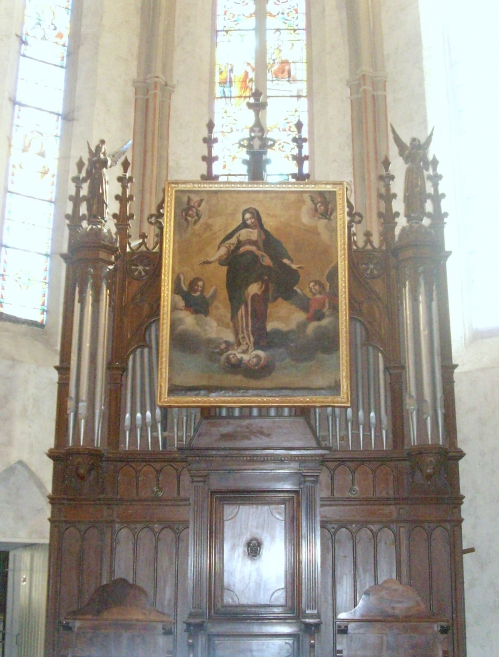
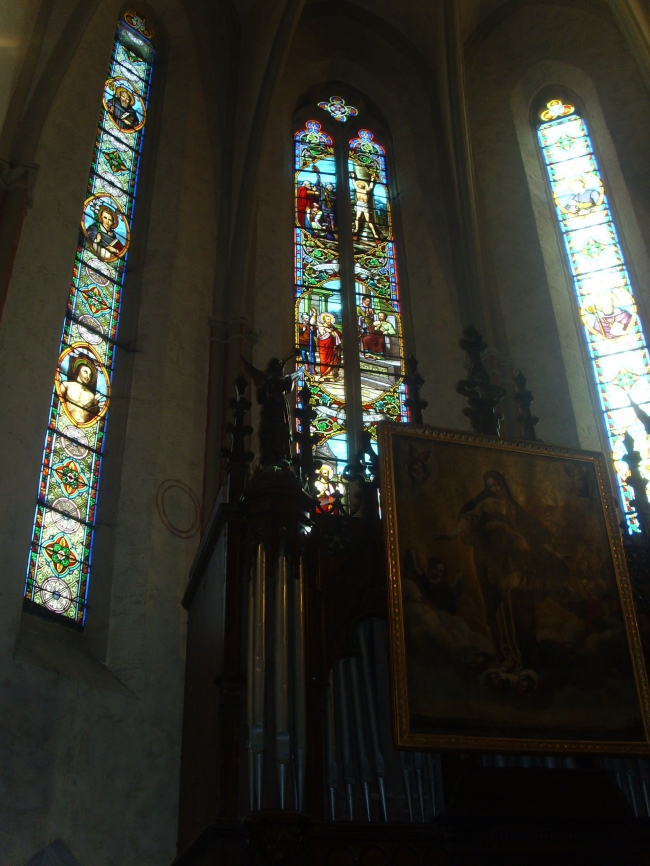
The stained glass window behind her is difficult to photograph, but unusual, in that it shows the scourging and judgement of Jesus by Pontius Pilate. Meanwhile, which Mary? The picture represents her taken up to Heaven by angels, but I thought that was a Mary Magdalene tradition, from the Provençal "Golden Legend."
The church is quite old, no-one knows exactly when it was built, but it seems it existed when Alet-les-Bains was made a diocese (area ruled by a Bishop) under Bishop Barthélemy in 1318. During the renovations, medieval frescos were found that must have covered all the interior walls. Here's one of the crucifixion.
On the left we see a bearded figure, possibly Joseph of Arimathea, with Jesus' mother Mary. And on the right? If that is Mary Magdalene and the centurion Petronius, she certainly appears to be pregnant. Compare this with Station 12 of the Cross;
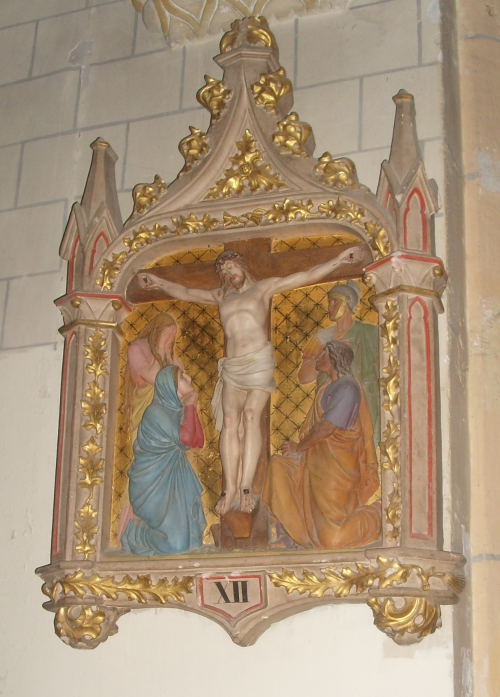
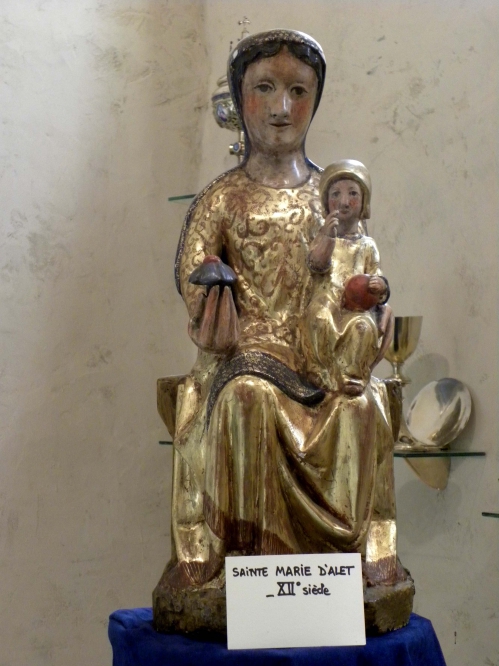
Here we can see Mother Mary in Blue, Mary Magdalene in pink, crying, Jesus, Petronius, and the Beloved Disciple, which many name John but I believe is Lazarus. Also, Alet church has it's own Black Virgin, from the 12th century, implying a church was there then.
Side chapels were added to the church in the 15th century and then, in 1577, Alet was taken by the Calvinists. That was when the cannon balls destroyed parts of the cathedral, but it seems that the church was left alone. One wonders why. Remember the cathedral was an abbey, ordinary people did not worship there, and maybe it was the monks the Protestant enemy was after.
In the seventeenth century "important work was done on the decorations" and in the 18th century, as part of the Revolution, the church became a "Temple Decadaire." Gradually the original use returned and in 1879 Bérenger Saunière worked as an assistant priest, when renovations were beginning that would have been completed in 1880.
I finish with a stain glass window of the death of Joseph, Jesus's stepfather. Jesus is represented as quite young. Joseph, by his actions when Mary was pregnant, saved the lives of both of them; he is the unsung hero of the Bible.
I found this image quite moving.
There is much more about the religious life in Alet in my book - click here.
In the Gardens
In front of the Angel Gallery is a public garden, and there I saw this statue of a lion, with a carved plaque underneath it.
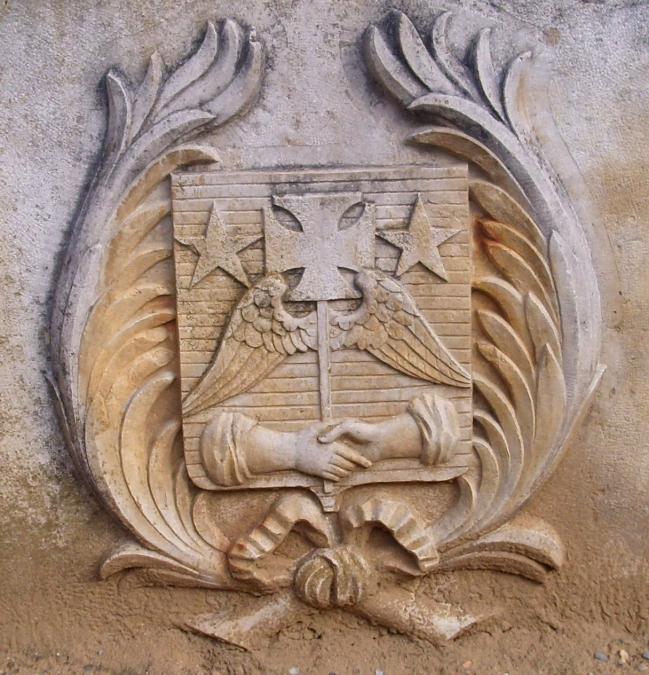
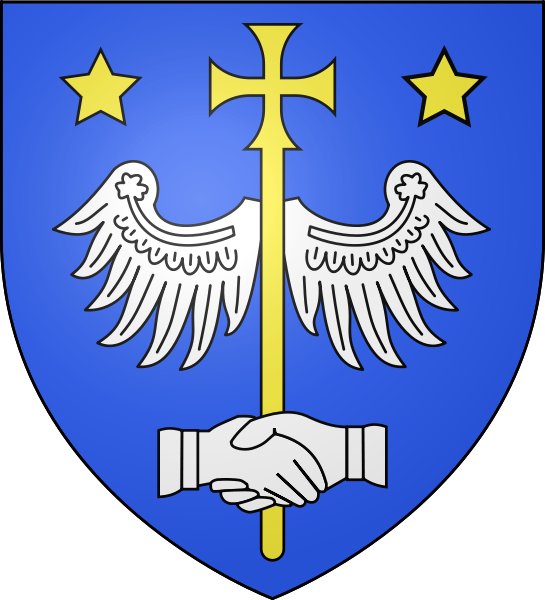
What is the most surprising is that the town's official coat of arms is the same basic design. In a time when freemasonry was forbidden by the Church, freemasonry was common in Alet, so much so that it is remembered on the modern coat-of-arms. Extraordinary!
The secret of the lion is fully revealed in my book about Alet-les-Bains. Click here.
Celtic and Roman history
Some of the thermal baths were used in Roman times, so it is well-known the Romans lived at Alet, but their interests there were mostly commercial as the River Aude, running alongside the town, was used to transport good from the Higher part of the High Valley of the Aude, to Carcassonne. The Celts used to do this too, especially coming northwards from Couiza. For an in-depth article about the Roman roads and industries at Alet, click here.
Pallas Athena
This is the statue that many people see in the main square in the centre of the old town, and think it is of Diana; but it is the Greek Goddess Athena, called Pallas Athena. She was a Goddess of truth and justice, which is why she always wore a Helmet of Truth.
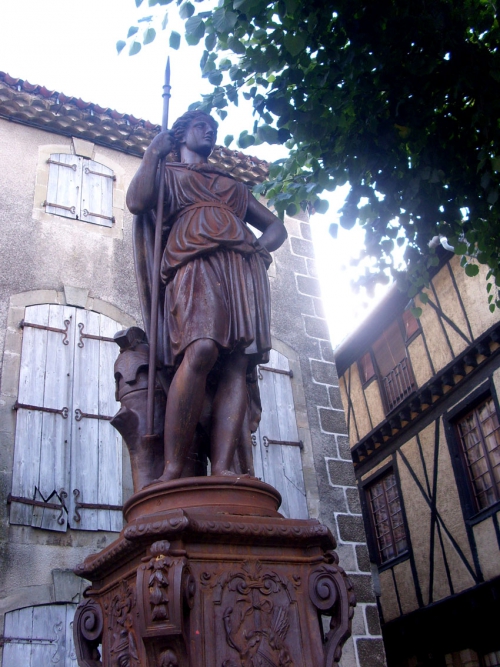
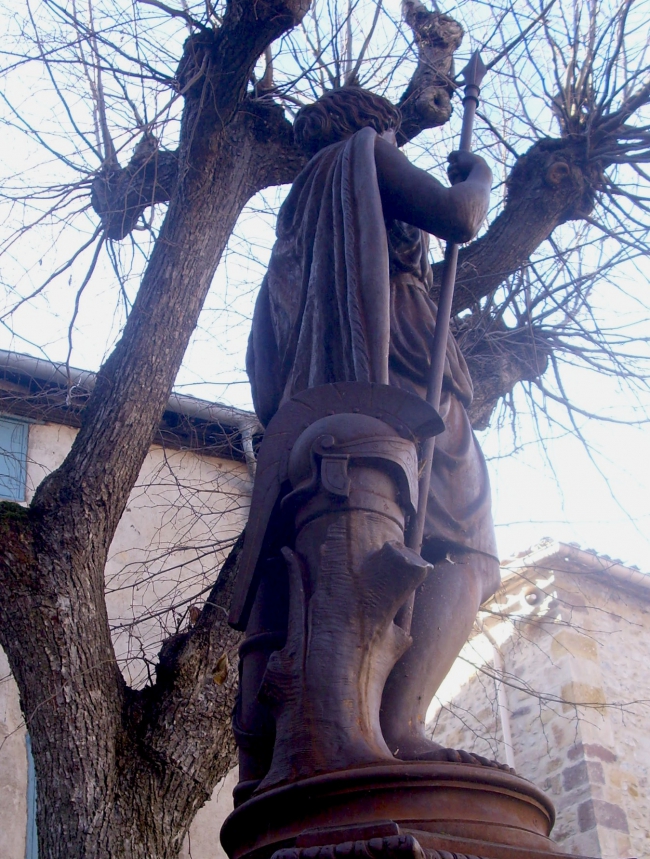
But in Alet she has taken off her helmet. Why? And the carvings on the plinth are definitely pagan.
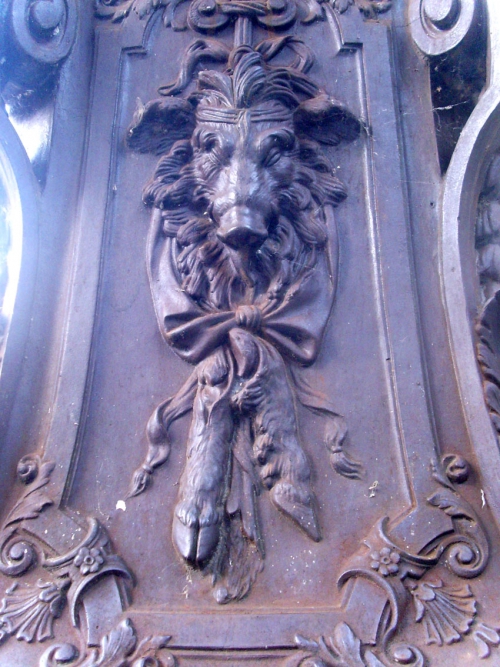
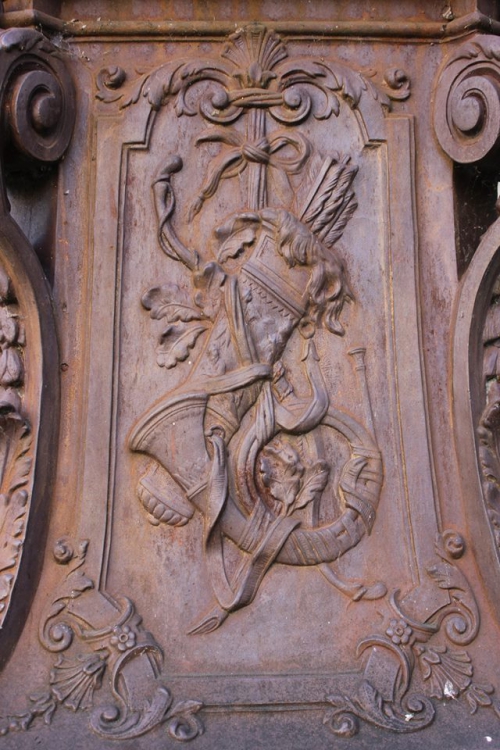
MOST intriguing. I think the masons were telling us something. The official story of the village is that the statue represents the Republic and the images on the plinth represent the hunt. (You know "the hunt" - la chasse - is a big thing in Corbières villages.) I unravel the story in my book.
Nostradamus lived opposite this statue.
Pierre Droite and St. Salvayre
The tiny hamlet of St. Salvayre is signposted from Alet, for it is part of the commune although 5 kilometres away.
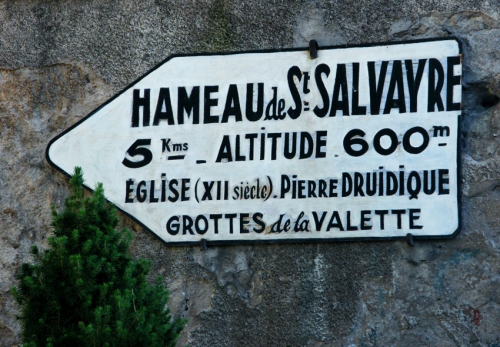
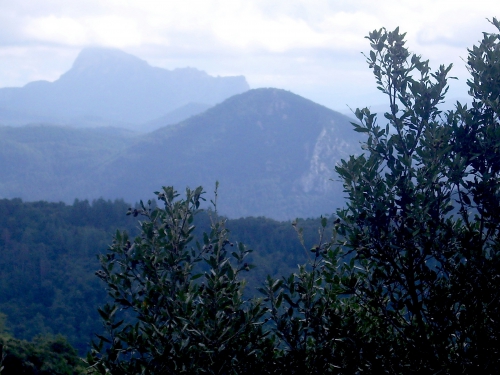
It's a steep but wonderful drive with views of Mont Cardou and Bugarach mountain, on the far side of Rennes-les-Bains. First, we wanted to see the Pierre Droite, which is marked on the map but difficult to find if you don't know where it is. Luckily, Trebha was with us.
Follow the road past the radio masts for almost exactly 700 metres. (I am convinced this is an old Roman road going from St. Salvayre to Vendemies near Limoux.) One finds the standing stone through the tiniest gap in the hedge.
It's said that only psychic people can feel the energy of this ancient Druid stone.
Then we went back to look at St Salvayre church, which itself has a fascinating history. You can read much more here.
In short then - there is much more at Alet-les-Bains than meets the eye!
Inscrivez-vous au blog
Soyez prévenu par email des prochaines mises à jour
Rejoignez les 97 autres membres

